Additional notes (click to expand)
Horticulture
Tuberous perennial with rounded leaves, 2.5-6cm long, either shiny, or unmarked, and deep green, or deep green with silver patterns. Compact flowers, 0.8-1.5cm long, varying from white to shades of pink and carmine-red with dark carmine-red stains above white-rimmed mouths, are produced with the leaves in winter and early spring, It grows to 5-8cm (2-3in) high by 10cm (4in) wide.
Brickell, C. (2003). A-Z Encyclopedia of Garden Plants. Dorling Kindersley. p.335
Plant 3-5cm deep. Grow in moderately, fertile, humus-rich, well-drained soil in partial shade, under shrubs or trees, to avoid excessive summer moisture. Mulch annually with leaf mould as leaves wither; in areas with prolonged frost, provide a deep, loose mulch.
Brickell, C. (2003). A-Z Encyclopedia of Garden Plants. Dorling Kindersley. p.335
To propagate, sow seed as soon as ripe, in darkness, at 6-12°C (43-54°F). Before sowing, soak all seed in water for at least 10 hours and rinse thoroughly. In terms of pests: mice or squirrels may be a problem.
Brickell, C. (2003). A-Z Encyclopedia of Garden Plants. Dorling Kindersley. p.335
The Cyclamen genus contains 23 species. In the wild, their distribution is centred on the Mediterranean, being natives of parts of Europe, western Asia and parts of North Africa. Cyclamen are tuberous plants that have no obvious affinity with primroses (despite being in the same family). They do resemble the North American Dodecatheon in having reflexed petals. Their habitats range from beech woodland, through scrub and rocky areas, to alpine meadows where they flower in snow meltwater.
The genus is notable for the fact that although it is small, there are species which flower in every month of the year.
The Cyclamen Society http://www.cyclamen.org
link
Medicinal
Culpeper: Under ‘Roots’ he writes: ‘ a most violent purge, dangerous; outwardly applied to the place, it profits much in the bitings of venomous beasts, also being hung about women in labor it causes speedy deliverance.’
Culpeper, Nicholas. (1650). A Physical Directory . London, Peter Cole.
Culpeper: ‘Sow bread, it is so dangerous a purge that I dare not take it myself, therefore would I not advise others. outwardly in ointments it takes away freckles, sunburning and marks that Small Pox leaves behind; dangerous for women with child, yea so dangerous that both Dioscorides and Pliny say that it will make a woman miscarry if she do just stride over it.’
Culpeper, Nicholas. (1650). A Physical Directory . London, Peter Cole.
Dioscorides is thought by John Goodyear to be referring to Cyclamen graecum, when he writes ‘They say that if a woman great with childe doe go over ye roote, that shee doth make abortion, and being tyed about her it doth hasten the birth.’ and clearly attributes this to an earlier author.
Gunther, R.T. (1938). The Greek Herbal of Dioscorides ... Englished by John Goodyear.
John Gerard recommended the plant for all manner of complaints. He wrote of powdered roots curing jaundice and “stoppings of the liver”. He even went so far as to say that the leaves, stamped in honey and applied to the eyes, cured “all impediments of the sight”.
Gerard wrote of the plant’s use for less serious complaints, such as clearing “tough and grosse flegme” and removing “Sun-burning, and all blemishes of the face”. It does not only appear to have been used facially, either: “[the juice] doth open the Hemorrhoids, and causeth them to flow”.
Gerard said - 'it is reported to me by men of good credit, that cyclamen or sow-bread groweth upon the mountains of Wales; on the hills of Lincolnshire and in Somerset-Shire. Being beaten and made up into trochisches, or little flat cakes, it is reputed to be a good amorous medicine to make one love, if it be inwardly taken'..
Gerard, J. (1975) The Herbal or General History of Plants. Dover Publications p.845
Nomenclature
Name a contraction of Greek, kyklaminos, from kyklos, a circle, alluding to the coiled stem of the seed vessel.
Stearn, W.T. (1996). Dictionary of Plant Names for Gardeners. Cassell. p.110
coum- of the Island of Kos in the Aegean Sea.
Stearn, W.T. (1996). Dictionary of Plant Names for Gardeners. Cassell. p.106
Toxicity
Poisonous glycosides are produced in Cyclamen.
Geographical distribution
- Asia-Temperate, Caucasus
- Asia-Temperate, Western Asia, Iran
- Asia-Temperate, Western Asia, Lebanon-Syria
- Asia-Temperate, Western Asia, Palestine
- Asia-Temperate, Western Asia, Turkey
- Europe, Eastern Europe, Ukraine
- Europe, Southeastern Europe, Bulgaria
Cyclamen coum Mill.
Family: PRIMULACEAEGenus: Cyclamen
Species: coum Mill.
Common names: Eastern Sowbread
Distribution summary: Eurasia
Habit: Perennial
Hardiness: H6 - Hardy; very cold winter
Habitat: Woodlands
Garden status: Currently grown
Garden location: Plants of the World (C)
Flowering months: January, February, March, December
Reason for growing: Medicinal, toxic
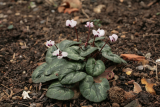
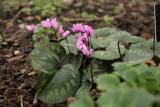
.JPG)
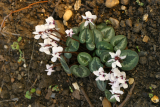

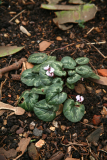
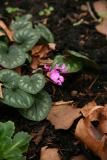
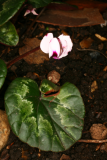
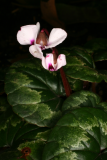
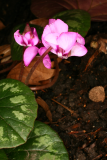
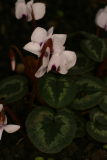
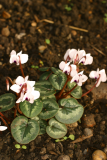
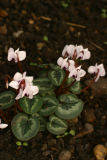
.JPG)